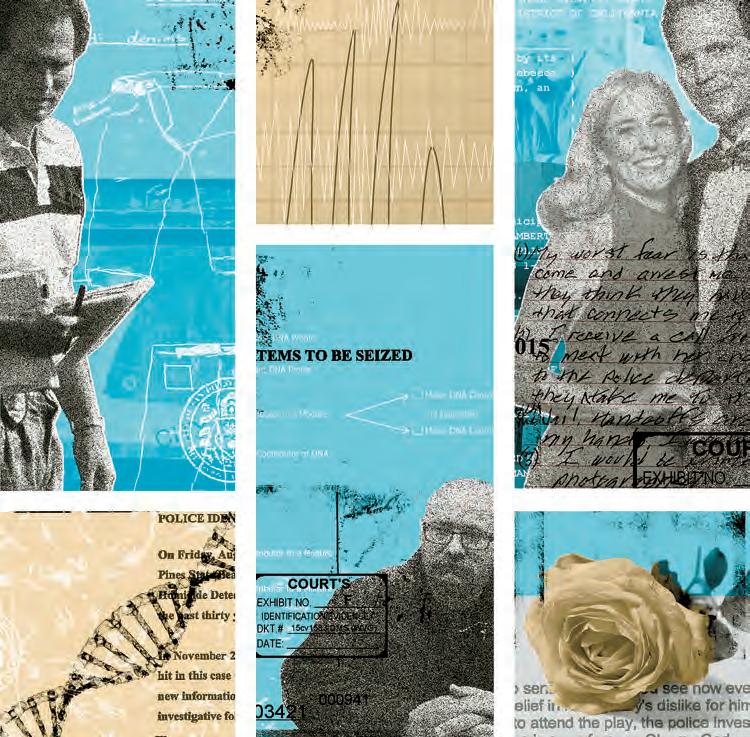
2 minute read
ACOLD CASE, ADNAHIT AND FINALLY JUSTICE... OR WAS IT?
ThirtyyearsafterClaireHough was murdered,anew round of forensic testingpointed to two suspects. One of them was familiar to thepolice.
ThemurderofClaire PenelopeHough wasthekindof mysterythat keeps homicide detectives awake atnight, pulling atloose threads. For almost 30years, they’d tugged and tugged andcouldn’tunravelit. Now they wanted to try again. Theirpersistence was due partly to Hough’s age—a month shy of 15 when she was sexuallyassaulted andstrangled on an Augustnightin 1984. Cops have teenage daughters, too.
Advertisement
Part ofit was thesavageryof the attackat Torrey Pines State Beach She was battered inthefaceandslashedon theneck Sand was stuffed down herthroat.Her left breast was cut off.
So yes, they wanted to catch thismonster, even asthe years ticking bymade that more difficult Time isnoally to crime-solvers: evidencedegrades,witnessesdie detectives get assigned to othercases.
Butas the calendar advanced sodidscience.
Every coupleof years,new techniquesor equipment would comealong, offeringhope to cold-casedetectives working unsolved murders. They would retrieve old items stored in evidence rooms andasktheforensicscientists to have another go.
Soit was inthesummerof2012 that LynnRydalch, a San Diego Police Department homicide detective,sent anemail abouttheHough murder to thedepartment’s lab.
“Idon’t want to leave any stoneunturned,”hewrote. “Any ideas you have forsomething that mighthave beenmissed would be greatlyappreciated.”
The request went to criminalistDavid Cornacchia He’s an expert inDNA,the increasinglysophisticated identification ofcriminalsuspects from even thetiniest bits of blood,salivaandotherbodily fluids. Sinceitsintroductioninthelate 1980s, ithas revolutionizedcrime-solving, consideredsoirrefutableas evidencethatit spawneda maxim:“DNAdon’tlie.”

Earlier testsdone overthe yearson clothingandother evidence located stainsthatappeared to be fromhumans. Butthelabnever hadenoughmaterial to linkit to anybody.
This time,usingmore powerful tools, Cornacchia extractedDNA,amplifiedit, andcreated a geneticprofile.Heranit throughlaw-enforcementdatabases to see ifthere wasa match. InHollywoodmovies television cop dramas andtrue-crimepodcasts, this is theswellingmomentofdelicioustruth.
Lady Justice rebalances herscalesand reachesacrossthedecades to tap a bad guy ontheshoulder.
Sometimesshetapsin reallife, too.
BloodspotsonHough’s jeans and underwearcameback to a felonnamed Ronald Tatro. Hiscriminal record includedrapinga womanatknifepointinArkansasin 1974 andattempting to kidnap a teenager in La Mesain 1985after zappingher twice with a stun gun. He once checked himselfintoa psychiatricclinic,troubledbyhisinability to controlviolenturges.
Finally itseemed,theplanets had aligned to solve Claire Hough’s 28-yearoldmurder. Butthere wasa complication. Cornacchiaalso gota DNA hit on vaginalswabs collectedallthose years ago duringthe girl’s autopsy Andit wasn’t Tatro. Thespermcellsbelonged to someone familiar to thecrimelab.Heused to work there.
KevinBrown grew upin Sacramento,the youngest of two children.
Hisfather wasa podiatrist hismotheran administrative assistantinstate government.He went to CalState Sacramento and gota bachelor’s degree in forensicscience.After he graduated,in 1979, hestarted workingas a criminalist forthe New Mexico state police. Brown likedthe job butnotthelocation.He wasa Californian at heart Three yearsin,hemoved to theSanDiego policelab.Hestayedfor20 years, rotating throughvariousunits narcotics, firearms,serology, trace evidence before leavingin2002.
Adecadelater hisDNAshowed upin theHoughcase.Anditstunnedthepolicelab. Manager JenniferShenandother supervisorshuddledbehindclosed doors,trying to figure outwhatthe result meantandwhat to doaboutit. Shenknew Brown.Theyhadbeenin thesamelabforseven yearsatthebeginning of hertimethere andtheendofhis. She remembered himas“a very pleasant person” andhadenjoyedtheiroffice interactions. It was upsetting to think that oneof their own couldbe a murderer especiallysomeone who was byallaccounts mild-mannered, even timid. Brown was 6-foot-4butnotimposing.
Murderedwhilevisitingher grandparentsin 1984,Claire Hough was 14 yearsold.
TOP:Claire wasdrawn to the water, both athomeinRhode Islandandwhenvisiting San Diego.Shefoundthesetting peaceful.Thisarea,at Torrey Pines StateBeach,iswhere she waskilledin 1984,althoughthe bridgeisdifferentnow.It was replaced in 2012.
K.C.ALFRED U-T
He was someone whosebossesdinged himin evaluationsfor gettingrattled and tongue-tiedduring courtroom testimony. Onefemalecriminalist considered him “weak-jellied” andsaid, “I could beat the crapoutofhimmyself.”
ButifBrown didn’thave itinhim to assaultHough,thatmeanthisDNA woundupinthe evidencethrough contamination, a prospectthatpresentedits own worries to labmanagement.It would make themlookbad,raisequestions abouttheintegrity ofthe work there.
Inadvertent contaminationhappens with surprising regularity incrimelabs. Techniciansbrushupagainst a bicycle or cough over a handgunandtheirDNA windsupinthemix.
Theypickup a penusedbysomeone else,andtransferthatperson’s DNA onto apiece of evidence downtheline.
That’s whyBrown andothercriminalistsprovide genetic samplesforthelawenforcementdatabase, to weedoutmistakeswhentheyhappen.
ButBrown’s DNAintheHoughcase wasn’t from wandering skin cellsordropletsofsaliva.It was sperm,onvaginal swabs. Lab managershadnever encountered sucha thing. Theyunderstoodhow it couldhappen,intheory. It’s little-known outside labs,butcriminalists routinely keep their own semenat work deposited onsmall piecesofclothknownasstandards.The samplesare used to make sure test chemicals are properlydetectingthe presenceofsperm.
Ifananalystsomehow broughta semen standard in contactwith a pieceof evidence,that couldcause contamination.








